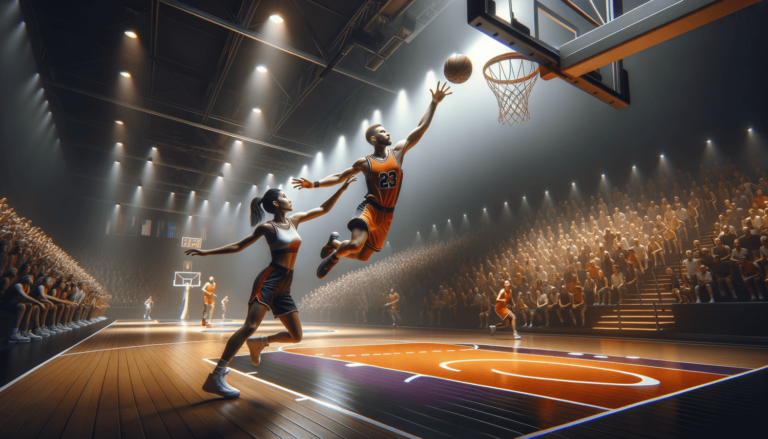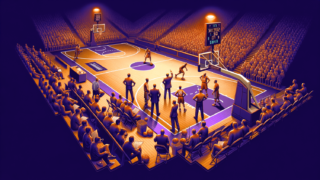
What Is a Lob in Basketball?
Written by: Basketball Universe
Last updated:

From high-flying dunks to jaw-dropping alley-oop finishes, the game of basketball is often peppered with awe-inspiring plays. One exhilarating move that captures fans’ attention is the ‘lob.’ For those eager to unravel the dynamics behind this show-stopping play, you’ve landed in the right place! In this blog post, we’ll dive deep into the ins and outs of a lob in basketball – a play that combines a graceful arc, precise timing, and exceptional teamwork. So, lace up your sneakers, and let’s embark on a journey to uncover the secrets behind one of basketball‘s most electrifying moves!
What Is a Lob in Basketball?
A lob in basketball is an offensive play where a player lightly and accurately passes the ball high in the air towards the basket, allowing a teammate to catch it mid-air and complete the play with an alley-oop dunk or layup. The lob is a display of effective coordination, precise timing, and agility between the passer and the receiver, typically executed during fast breaks or half-court sets to take advantage of mismatches and circumvent defenders.
The Technique Behind a Perfect Lob
Developing a keen understanding of essential techniques is critical for executing a breathtaking lob in basketball. Essentially, players need to master the fine balance between power and control to send the ball soaring accurately through the air. For a captivating dissection of the lob’s crucial components, let’s dive into its nitty-gritty.
Passing the Ball
Executing a textbook lob revolves around the passer’s ability to project the ball precisely. It entails not only the accurate consideration of distance, height, and arc but also the proper anticipation of a teammate’s movements. A successful lob pass should be light, high enough to avoid defenders, and dropped into the receiver’s path. Here are a few tips for mastering the art of lob passing:
- Visualize the arc – Aim for a spot above the rim, taking note of the path the ball needs to travel to reach your teammate.
- Lead the receiver – Release the pass slightly ahead of your teammate’s path to allow them to continue their momentum and avoid awkward adjustments mid-air.
- Feather touch – Lightly snap your wrists as you release the ball to give it the desired height and trajectory. Remember, a delicate touch is key.
Receiving the Lob
The receiver’s part in completing a lob is equally crucial. This player must demonstrate exceptional timing, elevation, and ball handling skills to flawlessly finish a lob pass with a dunk, layup, or tip-in. Following are some vital tips for receivers:
- Athleticism and explosiveness – Work on your vertical leap and speed for optimized elevation and smooth maneuvering when reaching for the lob pass.
- Timing is everything – Anticipate the lob, time your jump correctly, and maintain perfect coordination with the passer to increase the likelihood of success.
- Secure ball handling – Practice controlling the ball with one or two hands mid-air, ensuring clean receptions and minimization of turnovers.
- Finishing strong – Be prepared to complete the play by either dunking, laying it in, or tipping it. Solidify your finishing skills to avoid wasted opportunities.
Successfully Implementing the Lob in Different Basketball Scenarios
Understanding how and when to unleash a lob during various basketball scenarios can be the difference between a rattling basket and a disappointing miss. Let’s delve into how astute players can incorporate lobs into different gameplay situations to break down defenses and electrify the audience.
Lobs During Fast Breaks
Fast breaks present a fantastic opportunity to electrify the court with a stunning lob finish. In such instances, defenders are scrambling to recover, and the offensive player can intelligently exploit the gaps for a crisp lob pass. Upon recognizing a teammate sprinting ahead, employ the aforementioned lob passing techniques to deliver an enthralling alley-oop moment.
Pick and Roll Situations
Executing a lob via a pick and roll can potentially decimate an opposing team’s defensive schemes. After setting a strong pick, the screener can slip behind the defensive line or pop-out to catch an off-guard defender, providing the perfect scenario for a lob. Suppressing the urge to rush is crucial; a patient yet decisive approach can reward you with an alley-oop finish.
Backdoor Cuts and Misdirection Plays
Strategic backdoor cuts or misdirection plays can generate ideal lob scenarios. A well-timed backdoor cut, accompanied by a skillfully deceptive misdirection play, can leave the defense in a lurch. Mastering the elements of a lob pass in these scenarios requires immense practice, trust, and synchronization between the passer and the receiver.
Establishing a Flourishing Connection with Your Teammate
A memorable lob in the game of basketball is often the result of a remarkable connection between teammates. Two players operating in perfect harmony can make the lob appear like a seamless ballet in motion. Consequently, nurturing a reliable, cohesive partnership is essential.
Understanding Body Language
Reading and interpreting subtle cues is central to a successful basketball partnership. Much of the game is played with nonverbal communication, so it’s crucial to recognize the ideal time for a lob pass based on a teammate’s subtle body language.
Anticipate the Movements
Great players have an uncanny ability to anticipate their teammate’s actions, allowing them to react and time their passes with surgical precision. Building such a connection usually requires hours of practice, watching film, and constantly communicating with your teammate on and off the court.
The Importance of Trust and Confidence
Similar to any successful partnership, fostering trust and confidence between lob passer and receiver is paramount. This entails practicing and performing together repetitively, affirming one another’s abilities, and supporting each other through both successes and failures on the court.
Defensive Countermeasures Against Lobs
While an impeccably executed lob is difficult to defend, defenders must be prepared to counteract such plays. Let’s explore the various tactics used to protect the hoop against a potential lob assault.
Striking the Right Balance
Recognizing and disrupting a lob attempt calls for an intricate blend of anticipation, alertness, and athleticism. Defenders must be aware of opponents’ movements, communicate effectively, and monitor both the ball and player to remain poised to challenge a lob.
Communication Is Key
Defensive communication is the backbone of shutting down a lob. Players should stay vocal about their roles, such as who is providing help-side defense, ensuring a seamless transition in the event of an attempted lob pass. A relay of clear defensive assignments is essential.
Physical Disruption
Diving into the passing lane, crowding the offensive player, or applying pressure on the ball handler can all contribute to disrupting a lob. Nipping the play in the bud, rather than battling an aerial duel, may prove a more successful approach to halting a well-orchestrated lob.
Notable Lob Artists in Basketball History
The basketball landscape has witnessed some iconic lob pairings, wrought with lightning-fast passes and thunderous finishes. A trip down memory lane to revisit the greatest alley-oop duos can offer insight into the finesse and brilliance hidden behind a sensational lob play.
John Stockton-to-Karl Malone
Undoubtedly one of the most iconic duos in basketball history, John Stockton and Karl Malone of the Utah Jazz became synonymous with the lob. Stockton’s unparalleled court vision and Malone’s remarkable athleticism fashioned unforgettable alley-oops during their illustrious partnership.
Chris Paul-to-Blake Griffin/DeAndre Jordan
During their time with the LA Clippers, Chris Paul created a lob renaissance with two high-flying companions, Blake Griffin, and DeAndre Jordan. ‘Lob City’, as they were dubbed, redefined the art of the alley-oop, treating basketball fans to a dazzling array of above-the-rim acrobatics.
LeBron James-to-Dwyane Wade
Between 2010 and 2014, the Miami Heat brought the “big three” Lob Show, crafted by LeBron James and Dwyane Wade. LeBron’s versatility as both a passer and finisher, combined with Wade’s athleticism, made their lobs feats of incomparable artistry.
Mastering the Art of the Lob
Becoming proficient in the delicate dance that is the lob demands persistent training, precise timing, and seamless partnership. With practice, dedication, and a keen understanding of basketball principles, players can establish themselves as formidable lob artists – capable of unraveling defenses and captivating audiences with their high-flying alley-oop executions.
Benefits of Incorporating Lobs in Your Game
Now that we’ve explored the mechanics and strategies surrounding lobs in basketball, it’s time to illuminate the benefits of including this exciting play in your arsenal. Lobs not only keep the game flowing with thrilling moments, but they also provide advantages on the offensive end:
- Disrupting the defense: When executed properly, lobs exploit defensive mismatches and force opponents to stay alert for possible threats above the rim. This can create opportunities elsewhere on the court, as defenders may become preoccupied with countering the lob threat.
- Boosting team morale: A successful lob can inject energy and high spirits into a team. After witnessing an exhilarating alley-oop finish, teammates often rally together and ride the wave of momentum, maximizing their potential.
- Highlighting athleticism: The lob play allows versatile, athletic players to showcase their skills. Often, a well-timed and well-executed lob can elevate individual performances, as both the passer and receiver benefit from it.
- Unpredictability: Including lob plays in your game plan can fluster the opposition as it adds another layer of unpredictability to your offense, making the task of guarding your team all the more challenging.
Record-Setting Lobs and Memorable Alley-oop Moments
Over the years, basketball has witnessed numerous unforgettable lob feats and heart-stopping alley-oop plays. Let’s take a look at some of the most memorable moments that showcase the beauty and excitement of the lob:
2000 NBA Dunk Contest – Vince Carter’s Elbow Alley-oop
In the Slam Dunk Contest during the 2000 NBA All-Star Weekend, Vince Carter amazed spectators by catching a lob pass from teammate Tracy McGrady and performing a spectacular reverse 360 windmill dunk. The gravity-defying play left the audience in awe and solidified Carter’s status as a dunking legend.
2011 NBA Finals – Dwyane Wade-to-LeBron James Alley-oop
During Game 2 of the 2011 NBA Finals, Dwyane Wade threw a lob to LeBron James, who caught the ball mid-flight and completed the play with a jaw-dropping, one-handed slam dunk. This spectacular highlight showcased the sheer athleticism and artistry of the Miami Heat’s “big three” era.
2016 NBA All-Star Game – Russell Westbrook-to-Kevin Durant Alley-oop
As part of the Western Conference All-Star Team, Oklahoma City Thunder’s Kevin Durant and Russell Westbrook put on a show with their combination lobs. Durant connected with Westbrook on multiple occasions, displaying their incredible chemistry and thrilling the audience with electrifying dunks.
Great Lob moments in NCAA and International Basketball
While the NBA features numerous memorable lob moments, the basketball world outside the professional league is no stranger to jaw-dropping alley-oops. From college basketball to international competitions, lob plays have left their mark on every level of the sport.
2016 NCAA Championship – Villanova’s Kris Jenkins Alley-oop
In the semifinal game of the 2016 NCAA Championship, Villanova’s Josh Hart threw a lob pass to Kris Jenkins, who finished it with a powerful one-handed slam. The mesmerizing play was a significant highlight in Villanova’s unforgettable championship run.
2008 Beijing Olympics – LeBron James-to-Kobe Bryant Alley-oop
In the group stage of the 2008 Olympics, Team USA’s LeBron James and Kobe Bryant executed an iconic moment. James threw a precise lob to Bryant, who effortlessly caught the ball in mid-air and completed the sequence with a two-handed flush. The alley-oop play contributed to Team USA’s gold-medal-winning campaign known as the “Redeem Team.”
Captivating the hearts of basketball enthusiasts worldwide, the lob has maintained its status as a thrilling and strategic staple in the game. With adequate understanding, practice, and dedication, players can harness the potential of lobs, leaving a lasting impact on the court and the audience’s imagination.
Frequently Asked Questions
As a comprehensive supplement to our exploration of the lob in basketball, we’ve compiled a list of frequently asked questions. These engaging queries and concise answers will address the curiosity of readers, showcasing a wealth of knowledge around this spellbinding play:
1. What is the main purpose of a lob in basketball?
The primary purpose of a lob is to deliver a high, arcing pass that enables a teammate to catch the ball mid-air and complete the play with a dunk, layup, or tip-in. Lobs help exploit gaps in the defense, create unpredictable offensive opportunities, and energize the team.
2. What’s the difference between a lob and an alley-oop?
A lob is the high arcing pass, while an alley-oop refers to the play itself – when a player catches the lob pass in mid-air and finishes with a dunk or layup. Though often used interchangeably, the alley-oop specifically refers to the entire sequence of the play.
3. How can I improve my lob passes?
Improving lob passes involves practice and mastering the proper techniques, such as visualizing the arc, leading the receiver, and applying a light touch during the release. Regularly practicing with teammates will also enhance coordination and strengthen the understanding of each other’s movements.
4. Can a lob be used with short players?
Yes, although lobs are often associated with taller, athletic players, a well-timed and well-executed lob can still be successfully employed by shorter players, particularly in scenarios involving defensive mismatches or when defenders are caught off-guard.
5. How can I defend against a lob?
To defend against a lob, players should focus on anticipation, strong communication with teammates, and situational awareness. Close proximity to the offensive player, disrupting passing angles, and applying pressure on the passer can further reduce the chances of a successful lob.
6. How does a pick and roll complement a lob play?
A pick and roll can create a perfect scenario for a lob, as the sudden change in movement can catch defenders off-guard, leading to potential alley-oop situations. After setting a strong pick, the screener can quickly slip behind or pop-out, providing the opportunity for a lob pass.
7. Are lobs more effective in specific offensive schemes?
While lobs can be effective in a variety of offensive schemes, they are particularly potent during fast breaks, pick and roll situations, and backdoor cuts, where sudden movements or defensive mismatches can provide advantageous opportunities for alley-oops.
8. What kind of player is best suited for receiving lob passes?
Players with strong athleticism, a high vertical leap, and excellent timing are best suited for receiving lob passes. Additionally, those with good ball handling and finishing skills can contribute to enhancing the chances of a successful alley-oop.
9. Can a player receive a technical foul for hanging on the rim after catching a lob?
While hanging on the rim is generally prohibited, it is permissible immediately following a dunk to prevent injury, according to NBA rules. A player may receive a technical foul if they hang on the rim without a legitimate reason or carry out excessive celebrations.
10. Who holds the record for most alley-oop dunks in a single NBA season?
DeAndre Jordan, then of the Los Angeles Clippers, set a record during the 2013-14 NBA season by completing 252 alley-oop dunks. Jordan’s remarkable athleticism and chemistry with teammate Chris Paul contributed to this remarkable feat.
11. How important is communication when executing a lob?
Effective communication plays a critical role in executing a successful lob, both verbally and nonverbally. Passers and receivers should understand each other’s cues and signal intentions clearly to enhance the likelihood of a well-coordinated alley-oop.
12. How can I develop chemistry with my teammate for performing lobs?
Developing chemistry for lob plays requires consistent practice, studying each other’s movements and tendencies, and constant communication on and off the court. Building trust and confidence in one another’s abilities will also contribute to a stronger connection.
13. How can I incorporate lobs into my team’s offensive strategy?
To incorporate lobs into an offensive strategy, identify potential mismatches and opportunities within your team’s lineup, establish a strong pick and roll system, and develop effective communication between passers and
Featured Posts
- No pillar pages found.





